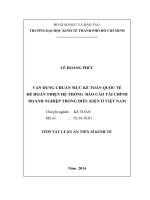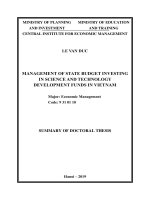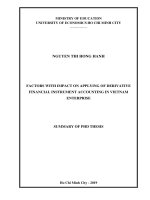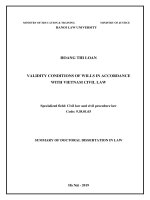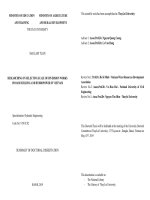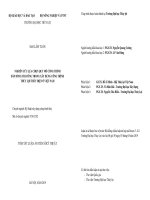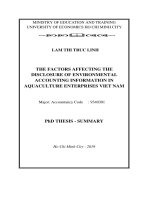Nghiên cứu lựa chọn quy mô công trình dẫn dòng thi công trong xây dựng công trình thủy lợi thủy điện ở việt nam tt tiếng anh
Bạn đang xem bản rút gọn của tài liệu. Xem và tải ngay bản đầy đủ của tài liệu tại đây (1.43 MB, 14 trang )
MINISTRY OF EDUCATION
MINISTRY OF AGRICULTURE
AND TRAINING
AND RURAL DEVELOPMENT
This scientific work has been accomplished at: ThuyLoi University
THUYLOI UNIVERSITY
Advisor 1: Assoc.Prof.Dr. Nguyen Quang Cuong
Advisor 2: Assoc.Prof.Dr. Le Van Hung
MAI LAM TUAN
RESEARCHING ON SELECTING SCALE OF DIVERSION WORKS
ON DAM BUILDING AND HYDROPOWER IN VIETNAM
Review No.1: Prof.Dr. Ho Si Minh - Vietnam Water Resources Development
Association
Review No.2: Assoc.Prof.Dr. Vu Huu Hai - National University of Civil
Engineering
Review No.3: Assoc.Prof.Dr. Nguyen Thu Hien - Thuyloi University
Specialization: Hydraulic Engineering
Code No: 9 58 02 02
This Doctoral Thesis will be defended at the meeting of the University Doctoral
Committee at ThuyLoi University, 175 Tayson str., Dongda, Hanoi, Vietnam on
May, 03rd, 2019
SUMMARY OF DOCTORAL DISSERTATION
HANOI, 2019
This dissertation is available at:
- The National Library
- The Library of ThuyLoi University
INTRODUCTION
diversion works. This study does not delve into the effects of turbulence, dynamic
1. Problem statement
circuits and downstream energy dissipation.
When designing a diversion works, the choice of flow rate, especially when the
4. Contents of the research
main structure is involved in diversion, still has many issues to discuss.
Overview of the diversion works on dam building and hydropower projects;
Flow diversion through the dam under construction help to save the cost of
Scientific and practical foundations for selecting design flow discharge; Building
diversion works in the flood season, how to select the scale of the diversion
algorithms and flow diversion calculation program; Selecting the scale of the
works, how the reinforcement of the dam is being built must have various options
diversion works to divert through the coffer dam that are under construction.
for calculation, and choose the most effective economic and technical options.
5. Research methods
The dissertation "Researching on selecting scale of diversion works on dam
Reviewing the methods of diversion works; Inheritance and practical research on
building and hydropower in Vietnam" is essential and important for the design
choosing the flow design discharge; Collect information and synthesize analysis;
and construction of dams and hydropower projects.
Application of informatics technology in computing and analysis.
2. Aim of the research
6. Scientific and practical significance
Reviewing the diversion works on dam building and hydropower; Add perfect
Synthesis method of analysis and hydraulic calculation for diversion plan;
methods of selecting the flow rate and the design discharge of the diversion
Contribute to the scientific foundations to select the reasonable scale of the
works; Analysis of constructive elements to serve a reasonable selection the scale
diversion works.
of diversion works through the dams that are under construction; Completing
calculation methods and algorithms for designing and selecting the scale of
diversion works.
Selecting the flow rate of the diversion works in accordance with the working
conditions of the structures; Proposing the order of calculation and selection of
the scale of the diversion works, determining the scale of the diversion works
3. Object and scope of the research
with the most effective in economic and technical options.
3.1. Objects of the research
7. Thesis contents
The main objective of this research is the diversion works on dams building and
The dissertation consists of 4 main chapters:
hydropower projects, with a focus on determining the scale of the diversion
works.
Chapter 1: Research overviews on flow diversion on dam building and hydropower
Chapter 2: Scientific foundations for selecting the design discharge of the diversion
3.2. Scope of the research
works and hydraulic calculation
The diversion works include two or more functioning structures at the same time;
Selecting design discharge, hydraulic calculations, and selecting the scale of
Chapter 3: Researching, analyzing and selecting the scale of diversion works
Chapter 4: Application of the research for dam building and hydropower in Vietnam
1
2
CHAPTER 1. RESEARCH OVERVIEWS ON FLOW DIVERSION ON
DAM BUILDING AND HYDROPOWER
1.1. The importance of flow diversion
Selecting the method of diversion works will affect the construction progress, the
time of river prevention, overflowing dams, expenses for diversion. Choosing a
reasonable diversion method will help save costs, reduce construction time while
still ensure construction quality.
When designing a diversion work, it is necessary to analyze specific conditions and
propose some of the most feasible options, through the economic and technical
calculations of each option then compare and choose the most optimal plan.
1.2.3. Hydraulic calculation
Hydraulic calculation software, hydraulic calculation materials are only calculated
for independent diversion works, not specifically mentioning the hydraulic
conductivity calculation when using two or more structures simultaneously.
This dissertation researches the setting up of a hydraulic calculation program to
guide the simultaneous flow through a dam under construction and a culvert gate,
to build a flow chart along the length of the flow through the dam that is under
construction, as a basis for determining scale of diversion works and measures to
reinforce the flow through the dam that is under construction.
1.3. River diversion through culvert and tunnel
1.2. Selecting the design discharge and calculating the hydraulic parameters
1.3.1. River diversion through culvert
1.2.1. Flow rate of the diversion works
Engineers should take advantage of long-term culvert to carry water for
construction, this makes the construction of the diversion works easier, avoiding
the difficulties and complexities of the culvert closure, while reducing the cost
for diversion works.
In the design codes and regulations in Vietnam, choosing the flow rate of
diversion works depends only on the level of construction, not mentioning
specifically the height of the water column, reservoir capacity when conducting
the flow, the recommendation to upgrade or downgrade on selection of the flow
rate is not clear. This makes it not only difficult for engineers to design the
diversion works as well as for the authorities to approve them but also difficult
to determine the flow rate.
In the case of many structures that carry the flow at the same time, the scale of
each structure to ensure technical and economic conditions is a common problem
for large discharge and construction during many years. The choice of the flow
rate in Vietnam needs to be adjusted to make it more clear and suitable with the
actual construction.
The diversion culvert is used to carry large floods under high water discharge
such as Son La project (2.568 m3/s), Lai Chau project (1.837 m3/s) and Bac Ha
project (1.134 m3/s).
1.3.2. River diversion through tunnel
The diversion tunnel can be used to conduct flow during both flood and dry
seasons such as Hoa Binh and Cua Dat works in Vietnam. China has a project of
Long Duong Hiep hydropower station, O Giang Do, Dong Giang, in India, there
is Si-li-sa-lam project, in the US there is Devosik, Paoerth...
1.2.2. The period of diversion works
To reduce costs, we often take advantage of the long-term tunnel to carry out the
diversion flow such as Hoa Binh (Vietnam), Mao Gia Thon (China)...
The selection of the flow rate and the period of diversion works will decide the
design discharge, this directly affects the scale of the diversion works.
1.4. River diversion through dam that is under construction
This dissertation analyzes the flow characteristics related to the selection of the diversion
periods, measures to handle special cases related to the regional flows in Vietnam.
Flowing through a rockfill dam is a form of cost savings for diversion in the flood
3
4
1.4.1. River diversion through rockfill dam that is under construction
season due to the ability to carry large flows. It is possible to apply this form to the
rockfill dams with the notation to the selection of the height of the overflow and
1.5. Conclusions of chapter 1
the width of the overflowing water to satisfy the conditions of each project, thereby
Diversion work is an important task, throughout the construction process, it is
having a plan to reinforce the overflow surface, ensuring safety and effectiveness.
important to the success or failure of a project. In order to select the diversion
1.4.2. River diversion through concrete dam that is under construction
plan as well as the scale of the diversion work, it must comply with the basic
Flowing through the concrete dam under construction is usually applied to gravity
concrete dam due to the characteristics of concrete is high abrasion resistance under
principles, suitable to natural conditions, people's life and economy and meet the
tasks of the project.
high velocity of the water flow. The flow through a concrete dam under
Large projects, long construction time, often use many types of diversion works
construction is often combined with a culvert located in the dam body.
and combine many disassembly works together. In the world and in Vietnam,
1.4.3. River diversion through earth dam that is under construction
there have been many successes as well as lessons learned about this issue.
When the flow is carried through the earth dam that is under construction with a
The researches of authors mainly focus on optimal parameters of hydraulic works
large flow, it can be applied to the base of the construction tray. In the last dry
and energy dissipation solutions, reinforcement of water drainage works but there
season, the foundation of the trench were excavated and waterproofing was applied
has not been a methodical proposal to solve decided the hydraulic problem
to the dam. At the end of the dry season, it is necessary to fill the foot of the finished
leading the general construction flow.
tray and reinforce the surface to carry the flow on the flood season. At the end of
River diversion through culverts, tunnels to help the construction of the dam site
the flood season, remove soil mud and surface cover, continue to build dams.
smoothly. Culverts in concrete dams and tunnels can use diversion
River diversion through dam and culvert, tunnel
simultaneously with other flood removal facilities to lead large flows in the flood
When there are many structures participating in the diversion, it is necessary to
season.
determine the design discharge for each project, this is a problem that requires a lot
The flow diversion through the dam that is under construction is a solution to
of calculation for each different diversion plan. Besides, it is necessary to determine
carry the large flow, the determination of hydraulic regime and measures to
the flow velocity at different locations in order to propose appropriate
reinforce the construction of the dam when the water overflow needs to be
reinforcement measures. Further research is needed on the evolutions on the
studied in more detail, serving the selection of the scale of diversion works.
surface of diversion works when conducting the combined flow through a
The model of river hydrodynamic calculation, irrigation canal system is not
construction dam and sewer, tunnel.
suitable for diversion hydraulic calculation, commercial calculation programs have
In addition to the hydraulic parameters of diversion works, conduction surface
not solved the calculation of hydraulic for diversion works and flow regulation. It
reinforcement for using dams to be built for diversion, attention should be paid to
is required to set up a hydraulic flow calculation program to serve the selection of
the volume and intensity of construction between the previous period and after the
the scale of the diversion works quickly and efficiently.
flow through the dam is under construction.
5
6
CHAPTER 2. SCIENTIFIC FOUNDATIONS FOR SELECTING THE
DESIGN DISCHARGE OF THE DIVERSION WORKS AND HYDRAULIC
CALCULATION
2.1. Analyzing and selecting the flow rate of the diversion works
2.1.1. Basis to select the flow rate of the diversion works
When using the main building as a diversion structure, it is necessary to select
the flow rate as the same level of the temporary structure or as the main buildings
will affect the cost of diversion works.
When proposing a diversion plan for some projects in the mountainous areas,
rapid flood concentration, high water column, in the event that dams cannot be
The choice of the flow rate, diversion period and diversion works are closely
overtaken, the embankment in this case will be very high. It is acceptable for
related. These three factors are the basis to decide the design discharge, the
embankment overflow and foundation overflow in the flood season.
working time of each diversion work and the hydraulic calculation diagram as
well as the determination of discharge flow through each structure.
The above comparison results also serve as a basis for the acceptance of flood
over the embankment and foundation pit. When it is acceptable for water to
The fact shows that the economic analysis is difficult, corresponding to each
overflow the pit, the ability to select small flow may reduce the cost of diversion
project will be different, so take the working time of the diversion works, the
work with low risk.
height of water barrier works, the largest capacity of the reservoir with each phase
of diversion as a basic indicator of the choice of the flow rate will be convenient
for use when conducting current design and convenient for risk analysis of
2.2. Determining the diversion period
2.2.1. Factors influencing the selection of diversion period
The diversion period is the working time of a water prevention structure such as
diversion plan.
2.1.2. Scientific foundations for upgrading or downgrading the flow rate
For the diversion works which are used only during construction, cost savings
issues are always in conflict with the possibility of risks. Choose a specific flow
rate that means accepting risk when the discharge exceeds the design value.
The flow rate selection method gives us a series of problems to determine the
flood damage beyond design: dam breaking, embankment overflow/foundation
overflow, damaging of the main or temporary buildings, influence on the
downstream areas if there are incidents...
The upgrading or downgrading of flow rate should have a technical and economic
feasibility research to decide. Thus, there will never be a specific increase or
decrease but must be based on specific analysis for each project and ultimately
a embankment or main dam and a water diversion such as a channel, drain or
spillway. The selection of the diversion period directly affects the design flow
discharge.
The period of flow diversion depends on hydrological conditions, structural
characteristics, diversion works, and the possibility of overcoming floods. It is
necessary to comprehensively analyze the above factors, from which to select the
appropriate diversion period.
2.2.2. Climate conditions and regional flows of Vietnam
In Vietnam, due to hydrological conditions in different regions, the dry season of
the regions is also different, divided into 5 areas: Northern Midlands and
Mountains, North Central, South Central and Tay Nguyen, Southeast.
the investor's decision. To what extent risk taking and the most difficult issue
Climate and hydrological factors affect the selection of the diversion periods
when making decisions.
according to regions of Vietnam. In particular, there should be a plan to cope
with unseasonal flooding at the end of the dry season.
7
8
2.3. Basis theory of hydraulic calculation for diversion works and flood
regulation
2.3.1. Hydraulic calculations through the dam that is under construction
Conducting the flow through the spillway in practice is very diverse.
Hydraulically it is equivalent to a practical spillway or a large spillway. Flow
regime includes submerged and unsubmerged.
Figure 2.9. Diagram of hydraulic calculation through a rockfill dam that is
under construction.
2.3.2. Hydraulic calculations through the culvert
Flow modes include open flow when H0 ≤ (1,2÷1,4)Hc; semi-pressure or pressure
with H0 > (1,2÷1,4)Hc, depending on the water surface. The value (1,2÷1,4)Hc is
selected as follows: The entrance is very convenient, then select 1,4Hc; Do not
convenient 1,2Hc.
2.3.3. Hydraulic calculations through two or more structures simultaneously
When calculating, it is necessary to determine the boundary conditions:
- The discharge through each structure must have the same upstream (Ztl) and
downstream (Zhl) boundary conditions.
Vmax is determined by the method of drawing the water surface according to the
equation (2-16).
∆E
=i− j
∆l
(2-16)
From the velocity and water column at the top of the slope, draw the water surface
and find the maximum velocity Vmax on the slop.
2.5. Conclusions of chapter 2
The selection of the design discharge closely related to the flow rate selection
and the selection of the diversion plan in which the diversion period is chosen.
- The total discharge at the downstream is equal to the sum of all discharge
through each structure.
Binding to them is the scale, structure of the main building and the natural
2.3.4. Flood regulation in river diversion
calculation to determine the scale of diversion works.
When the water level is low, the reservoir is very small or not yet formed, the
calculation of the diversion works does not consider the flood regulation. But
when the water barrier is high and the reservoir is large enough, it will have the
effect of regulating the flood. The dissertation uses the method of iteration
analysis to solve the problem.
The scale of diversion works is determined depending on the combination of
2.4. Calculating the maximum velocity when divert overflow rockfill dams
When the flow is carried over a rockfill dam, the parameters that greatly affect
the maximum flow Vmax are the unit discharge through the building dam (q), the
slope length (L) after the overflow threshold, slope of the spillway (m), difference
in height at the end of the slope compared to downstream water level (H2).
Calculation diagram as shown in Figure 2.9.
9
conditions of the construction site. Along with the above work is hydraulic
many factors: the scale of the main project, natural conditions, socio-economic
conditions, construction capacity, construction duration, and diversion plan... It
is necessary to compare the technical and economic calculations in accordance
with the specific conditions of each plan to select the appropriate diversion work.
One of the difficult contents in the calculation of diversion works is hydraulic
problems. This content needs to be specific and detailed in steps to help engineers
to avoid mistakes and calculate quickly. In particular, the focus is on hydraulic
parameters including: flow, water level, flow rate, geometric parameters... for
structures that are involved in the diversion works.
10
CHAPTER 3. RESEARCHING, ANALYZING AND SELECTING THE
SCALE OF DIVERSION WORKS
3.1. Research to select the flow rate and the period of the diversion works
3.1.1. Selecting flow rate of the diversion works according to the national standards
QCVN 04-05: 2012 has the following disadvantages:
The selection of flow rate of diversion works does not mention whether or not the
main dam is involved in water barrier, does not specify the effect of reservoir
capacity corresponding to dam height is under construction;
Increasing or decreasing of the flow rate does not specify how it makes it difficult
for designers and approvers of design;
When using under construction dam for diversion, it is necessary to use the
designed design flow rate to be too safe, not yet reflect the working status of the
diversion works when conducting the flow through the embankment dam being
built low elevation, not large reservoir capacity.
Figure 3.2. Applying the main dam according to the economic section
3.2. Producing hydraulic calculation program for diversion work and flood regulation
In the process of setting up the hydraulic calculation program, in accordance with
the different flow modes of the release works, the calculation formula changes
according to the boundary conditions. However, the baseball current does not
change the sudden mode from open flow to pressure flow. Meanwhile, semiexperimental formulas applied at water column transition points will give two
different results in terms of discharge. Therefore, it is necessary to deal with
algorithms at these locations in order to facilitate the calculation but not to make
big difference to the results.
3.1.2. Selecting the period of diversion in the Vietnamese climatic conditions
For constructions with time building greater than 1 year, it should be divided into
dry season and flood season. When choosing the periods, pay attention to select
the dry season period accordingly, the rest of the year will be the flood season.
There are two options to handle sub-flood at the end of the dry season:
- Option 1: Select the maximum flow of the dry season with the flow rate of
design as flow design flow for the dry season.
Figure 3.3. Correlation Q ~ H0 when
Figure 3.4. Correlation Q ~ H0
the flow change from submerged to
when the flow change from
unsubmerged
unpressured to pressure
- Option 2: Divide the dry season into 2 periods before and after the sub-flood.
Phase 1: From the beginning of the dry season to the end of the sub-period, select
the design flow which is the largest in those months, used to design diversion
works. Phase 2: From the month of sub-flood to the end of the dry season, choose
the largest flow of the month with the sub-flow, using the other phase-1 diversion
works, can release larger discharge. When applying this option, it is possible to
use the main dam with an economic section to reduce the construction intensity
of the construction phase beyond flooding (Figure 3.2).
The dissertation establishes a block diagram for hydraulic calculation through
culverts, hydraulic calculation combined with under construction dams and
culverts, calculating flood regulation. Calculation results show that the discharge
through the culverts and dam is under construction, the flow that is accumulated
in the reservoir. From the flow through the dam is under construction, calculating
the construction of water surface, hydraulic regime on the slope corresponding
to the different options. The hydraulic calculation program has been tested
against the experimental results of Lai Chau hydropower project.
11
12
3.3. Selecting the parameters when diverting flow through the under
construction rockfill dam
3.3.1. Research the effect of construction parameters to the maximum velocity
3.3.1.1. Effect of parameters to the maximum velocity
When changing the slope of the spillway (Figure 3.12), the maximum velocity
increases and increases rapidly when m = 4. With such a strong upward trend,
for a large length of slope, it is necessary to keep the slope of the spillway (m)
small to limit the maximum velocity appearing on the slope.
Figure 3.8. Water surface and
velocity movements
When difference in height at the end of the slope compared to downstream water
level increases (Figure 3.14), maximum velocity increases with a similar level at
both the small unit discharge and the large unit discharge level. Difference in
height at the end of the slope compared to downstream water level should be
minimized to limit the increase of maximum velocity.
3.3.1.2. General comment
With the same length of slope, the unit discharge and velocity Vmax depends on
the slope of the spillway (m). The smaller the slope of the spillway (m), the
greater the maximum velocity. Figure 3.15 (a), (b). When m <6, H2 = 0m, the
maximum velocity relation line with the unit discharge is separate from other
cases. Therefore, it is necessary to limit the use of slope of the spillway m <6.
Figure 3.12. Relations Q ~ Vmax case
L = 150m, H2 = 0m
Figure 3.13. Relations Q ~ Vmax
where m = 8, H2 = 0m
a) L = 50m; H2 = 0m
b) L = 200m; H2 = 0m
c) L = 50m; H2 = 15m
d) L = 200m; H2 = 15m
Figure 3.14. Relations Q ~ Vmax case
m = 8, L = 150m
When the unit discharge is small, changing the slope length has little effect on
the maximum velocity (Figure 3.13). When the unit discharge is large, the slope
length has more influence on the maximum velocity. The extension of the water
slope can be applied with a unit discharge of q <25 m3/s.m, with a larger unit
discharge, which should extend the overflow width to reduce the maximum
velocity on the slope.
13
Figure 3.15. Effect of parameter m, H2 to the maximum velocity
14
Considering the influence of H2 on Figure 3.15, when the slope length is small
(L = 50m), the height of H2 clearly affects the maximum velocity (in case (a)
Vmax = 17,5 m/s, case (c) Vmax = 23,1 m/s). When the slope length is large (L =
200m), H2 is less affected to the maximum velocity (in case (b) Vmax = 22,4 m/s,
the case (d) Vmax = 25,9 m/s).
From Figure 3.15 and Figure 3.16, difference in height at the end of the slope
compared to downstream water level (H2) has a strong influence on the maximum
velocity on the slope, so when selecting the under construction dam parameters,
it is necessary to limit H2, even keep H2 <0 (outlet of the slope is lower than the
downstream water level) as shown in Figure 3.17 to facilitate the connection and
the energy dissipation in the downstream.
Figure 3.17. Select the parameters of under construction dams for diversion
Through Figure 3.15 and Figure 3.16, selecting the unit discharge (q) small will
a) m = 16; H2 = 0m
b) m = 16; H2 = 0m
be favorable for reinforcement because the maximum velocity is not high, but
the small unit discharge will increase rapidly the width of under construction
dam. The author proposes to select q = (20 - 35) m3/s.m so that the width of the
dam is under construction can be acceptable.
3.3.2. Reinforce the dam surface when diverting flow over the under
construction dam
The dissertation uses the plan to reinforce the dam surface with ttb reinforced
concrete slabs. These slabs are connected by waterproof joints, preventing water
from penetrating into the dam body as shown in Figure 3.20.
c) m = 4; H2 = 15m
d) m = 4; H2 = 15m
Figure 3.16. Effect of parameters L and H2 to the maximum velocity
In Figure 3.16, the slope length affect the maximum velocity when H2 = 0 (case
(a) Vmax corresponds to q = 40 m3/s.m is 11,7 m/s, 14,3 m/s ; (b) Vmax
corresponding to q = 40 m3/s.m is 17,5 m/s, 22,4 m/s). However, when H2 = 15m,
this length has little effect on the change of maximum flow velocity (in case (c)
Vmax corresponds to q = 40 m3/s.m is 20,4 m/s, 21,5 m/s; case (d) Vmax
corresponds to q = 40 m3/s.m is 23,1 m/s, 25,9 m/s).
15
Figure 3.20. Reinforcing the surface dam for water overflowing a rockfill dam
Compared to the gabion reinforcement plan, the above reinforced concrete
reinforcement plan is more expensive, but there is no turbulent flow through the
dam body, which protects the transitional buffer layer from being destroyed by
the water flow. At the same time, there is no disturbance in the downstream,
limiting erosion of the rock under the concrete slabs, safer for concrete slabs to
reinforce the slope without the need of using steel anchors.
16
3.4. Conclusions of chapter 3
Selecting the flow rate of the diversion works as well as the ranks of diversion
CHAPTER 4. APPLICATION OF THE RESEARCH
BUILDING AND HYDROPOWER IN VIETNAM
construction effect to the cost as well as the level of risk tolerance in dams
4.1. Analyzing the selecting flow rate of the diversion works
building and construct hydropower.
4.1.1. Use under construction dam for diversion
FOR
DAM
Conditions of dry season flow and flood season in Vietnam vary greatly. It is
Figure 4.5. The flow rate of the diversion works when divert over under
necessary to select the suitable time and plan of diversion works for each area,
construction dam
especially to handle the period of sub-flooding, to reduce the cost for diversion
works.
Transitional algorithm processing is necessary to ensure continuously of the flow
Type of dam
1
Tuyen
Quang
CFRD
2004
+48,0
3,1
5%
5.036
x
2
Cua
Dat
CFRD
2007
+50,0
67,8
5%
5.050
x
RCCD
2009
+126,0
75,1
3%
16.044
x
x
RCCD
2014
+220
23,9
3%
10.388
x
x
been calculated and tested with many different cases of flow and parameters of
Lai Chau hydropower project. Calculation results are consistent with the
calculation results of design and testing model.
3 Son La
The main factors affecting the selection of the scale of the diversion works
4
through the rockfill dam are under construction, including the unit discharge, the
Evaluation of
conformity with
standards
N
o
and head water relation lines, avoiding errors occurring during the hydraulic
calculation of the calculation program. The hydraulic calculation program has
Reserv Flow
Elevation
oir
rate of
Year of under
capacit
the
of the constructi
y
diversi
flow
on dam
(millio
on
(m)
n m3) works
Name
of
constr
uction
Lai
Chau
Discha
rge
Result
(m3/s) Vietn
Russ
China
am
ia
x
Succes
s
Unsuc
cessful
Succes
s
slope of the spillway (m), the slope length, and difference in height at the end of
Cua Dat project when having a flow rate of 5% has encountered a problem, this
the slope compared to downstream water level. It is proposed to select the unit
project according to Chinese standards needs to select the flow rate design (1 ÷
discharge in the range (20 - 35) m3/s.m to reduce the width of the under
2)% or smaller to ensure safety for construction.
construction dam to be used for diversion. It is necessary to limit difference in
4.1.2. Use the main dam to participates in the river diversion
height at the end of the slope compared to downstream water level, even the outlet
of the slope is lower than the downstream water level to facilitate the continuation
and dissipation.
For the later phase, these flow rates are not in accordance with QCVN 04-05:
2012 because the designer proactively proposed to upgrade the flow rate to the
level of safety for the projects. These flow rates are accordance with Russian
With the results of the research, the designer can propose various plans for flow
diversion through the rockfill dam, thereby determining the maximum velocity
and the reinforcement form. Analyzing on the basis of the maximum velocity,
the cost of reinforcing, damming volume in the dry season before the flood
season and the dry season next year to select the most optimal plan.
17
standards.
The selection of suitable flow rate is very important to ensure the safety of the
project, although Vietnamese standards have not specified this issue but the
actual projects in Vietnam with long time construction has been active in
adjusting the flow rate during construction.
18
4.2.2. Calculate construction intensity and reinforcement cost
Figure 4.6. The flow rate of the diversion works when the main dam
participates in the flow diversion
Strength and reinforcement costs are calculated automatically by the program
Evaluation of
Water
Flow
Year High
conformity with
column rate of Discha
of
water
standards
before
the
rge
Result
the overflo
dam
diversio (m3/s) Vietn
Russ
flow w (m)
China
(m)
n works
am
ia
Name
of
constr
uction
Type of dam
1
Tuyen
Quang
CFRD
2005
+79,0
~62
1%
9.060
x
x
x
Succes
s
2
Cua
Dat
CFRD
2008
+85,0
~65
1%
7.520
x
x
x
Succes
s
RCCD
2010 +145,0
~75
0,5%
21.947
x
x
x
Succes
s
RCCD
2015
~ 80
0,5%
13.105
x
x
x
Succes
s
N
o
3 Son La
4
Lai
Chau
+275
calculated by the author. Users can change the input parameters to calculate for
different works and different options.
The construction volume between stages has been verified by the drawing
volume for one case in AutoCAD 3D. The result is correct.
4.2.3. Analyzing and selecting diversion parameters
4.1.3. Recommendation of selecting the flow rate of diversion works
Flow rate of diversion works through the stages should be chosen depending on
the importance of the main dam, the time of using the diversion construction to
divert flow, the height of the water barrier and the reservoir capacity
correspondingly to ensure safety and less damage downstream if the dam failure.
Figure 4.4. Maximum velocity
Figure 4.5. Cost of materials to
reinforce dam
Proposed amendments to Section 5.2.8, Table 7, footnote 4 of QCVN 04-05:
2012/BNN&PTNT: “When flood discharge is divert through the under
construction dam, there must be secured safety for dams and reservoirs. The flow
rate of diversion works in this case must be based on the level of risk depending
on the reservoir capacity corresponding to the water level and damage
downstream if a dam failure incident occurs; "
4.2. Selecting parameters of diverting under construction dam for Cua Dat
project
4.2.1. Input data
Figure 4.6. Construction volume of
Figure 4.7. Construction intensity
phase 1 and phase 2
phase 1 and phase 2
Selecting a plan through a under construction dam and a tunnel with a flow rate of
P = 2%, during the flow diversion is the 2007 flood season, the design discharge
leads to Q = 6660 m3/s. The dissertation calculates with the parameters of under
construction dams: Threshold level + 30m, + 40m, + 50m; Water overflow width
is 180m, 210m, 240m; Slope of the spillway m = 12; m = 8; m = 6.
Based on the maximum velocity analysis, the cost of reinforcing materials, the
19
20
volume of construction phase 1 and stage 2, the author chooses the option TH2-1-3
with parameters Zng = + 40.0, water overflow width B = 180m, the slope of the
spillway m = 6 to serve as a way to guide the diversion works through the
construction dam and tunnel.
4.2.4. Verify by numerical hydraulic calculation method
4.2.4.1. The 2D model flow diversion over the under construction dam
Figure 4.8. The model of calculating
the flow over the under construction
dam in two dimensions
Figure 4.9. Results of calculation
of flow over the under construction
dam
The flow has a horizontal disturbance on the under construction dam (Figure
4.16), more concentrated on the two sides of the slope, making the flow at
waterway TT4 and TT6 increase to 15,5 m/s. This calculation result is
consistent with theoretical calculation results. At the end of the slope due to the
impact of the downstream water level, the flow has a smaller flow than on the
slope but the high-velocity flow circuit is quite large, attention should be paid to
strengthening this area.
4.3. Conclusions of chapter 4
When using the main dam for diversion, constructions in Vietnam use a higher
flow rate of the diversion works than the Russian standard. Russian standards are
Maximum velocity at the end of slope Vmax 15.0 m/s. Calculation results are
safer than Vietnam and China.
consistent with theoretical calculation results. The velocity at the end of the slope
When the main dam participates in diversion at a later stage, large projects in
is very large, it needs strengthening in this area.
Vietnam have taken the initiative in adjusting the flow rate to ensure safety for
4.2.4.2. 3D model flow diversion over the under construction dam and tunnel
the project during construction. These flow rates are accordance with Chinese,
Russian and Vietnamese standards.
Selecting the flow rate of diversion works of the phases should be based on the
importance of the main dam, the time of using the diversion works to divert the
flow, height and type of water-blocking construction, capacity of reservoir
corresponds to the height of water to ensure construction safety and less damage
downstream if the breakdown incident during construction.
Figure 4.14. Model of flow diversion
through the under construction dam
and tunnel
Figure 4.15. Initial conditions of
flow diversion through the under
construction dam and tunnel
Based on the analysis of the maximum velocity, the cost for reinforcing the dam
surface, balancing the amount of dam in the period before the flood season and
after the flood season, the author proposes to select the parameters of under
construction dam for diverting: Zng = + 40,0m, B = 180m, m = 6. The hydraulic
calculation results for this plan are verified by Flow3D software, in accordance
with the calculation program of the dissertation.
For large and important projects, using under construction dam to divert flow during
Figure 4.16. Distribution of flow
over under construction dam
Figure 4.17. Distribution of flow
through the tunnel
21
the flood season needs to be carefully calculated and experimented to determine flow
regime, flow distribution, dynamic circuit to take appropriate reinforcement.
22
CONCLUSIONS AND RECOMMENDATIONS
The designer can offer a variety of diversion construction options, thereby
determining the maximum velocity and form of reinforcement. Analyzing on the
1. The obtained results
largest velocity, the cost of reinforcing and dam volume in the dry season before
The dissertation has an overview of selecting the scale of diversion works as well
the flood season and the dry season next year to select the most optimal plan.
as the achievements of the diversion when constructing dams and hydropower
For Cua Dat project, the author proposed to select the plan of under construction
projects in the world and in Vietnam.
dam for diversion: Zng = + 40,0m, B = 180m, m = 6. Results of hydraulic
The dissertation presents the basic theoretical in selecting of parameters of diversion
calculation for this plan verified by Flow3D software, the calculation results are
works and methods of calculating hydraulic for the selection of those parameters.
consistent with the dissertation's calculation program.
Selecting the flow rate of diversion works through the phases should be chosen
2. New contributions
depending on the importance of the main dam, the time of using the diversion
1) Proposing scientific foundation to determine the design flow discharge of the
diversion works corresponding to the flow rate and period of diversion;
construction, the height of the water and the reservoir capacity corresponding to that
height to ensure safety and less damage downstream if the dam failure. The dissertation
propose an amendment on selecting the flow rate of diversion works in QCVN 04-05:
2012/BNN & PTNT in case of divert flow over under construction dam.
2) Building the relationship between the shape and size of the under construction
dam with hydraulic regime when divert flow;
In the climatic conditions in Vietnam, it is necessary to select different periods
3) Develop a program to calculate and select the scale of the diversion
construction when using multiple diversion constructions.
of diversion in each regions, so it is divided into dry season and flood season,
3. Shortcomings and recommendations
paying attention to dealing with sub-floods at the end of the dry season.
The dissertation has developed a block diagram and a hydraulic flow calculation
program for different types of drainage works. The calculation program has been
verified via the results of experimental and real data of Lai Chau hydropower project.
3.1. Shortcomings
The program calculates in accordance with the calculation scheme not mention
to the hydraulic loss of the inlet channel, the interactions at culvert and under
construction dam while diverting. The dissertation does not mention the problem
The main factors influencing the scale of the diversion works over under
of energy dissipation in downstream of diversion works. When applied to
construction dam including the unit discharge, slope length, slope of the spillway,
practice, it is necessary to calculate the energy dissipation for the chosen option
difference in height at the end of the slope compared to downstream water level.
to obtain a complete diversion plan.
It is proposed to select the unit discharge in the range (20 - 35) m3/s.m to reduce
the width of the dam to be used for diversion. It is necessary to limit difference
3.2. Recommendations
in height at the end of the slope compared to downstream water level, even the
The later research of this dissertation is to consider the spatial problem of
outlet of the slope is lower than the downstream water level to facilitate the
diversion works, the interaction effect when multiple diversion constructions
continuation and dissipation.
work at the same time, the movement of the flow velocity and the pressure on
the water slope.
23
24
PUBLICATIONS OF THE AUTHOR
1. Mai Lam Tuan, "Selection of the maximum flow rate for the river flow
diversion design for constructions when the main construction is involved in the
flow diversion", Journal of Water Resources and Environmental Engineering,
ISSN 1859-394, no. 60, pp. 89-93, 2018.
2. Mai Lam Tuan, "Determination of water level - discharge relationship for flow
diversion through under construction dam and culvert", Journal of Water
Resources and Environmental Engineering, ISSN 1859-394, no. 60, pp. 83-88,
2018.
3. Mai Lam Tuan, "Flow diversion through under construction dam when
building dam and hydropower”, Proceeding of the annual conference on National
water resources, ISBN 978-604-82-2273-4, pp. 7-9, 2017.
4. Mai Lam Tuan, Le Van Hung, "The rivers diversion works for Cua Dat dam
2005-2009 end flood hazard on October 4-2007", Journal of Water Resources
and Environmental Engineering, ISSN 1859-394, no. 48, pp. 77-84, 2015.
